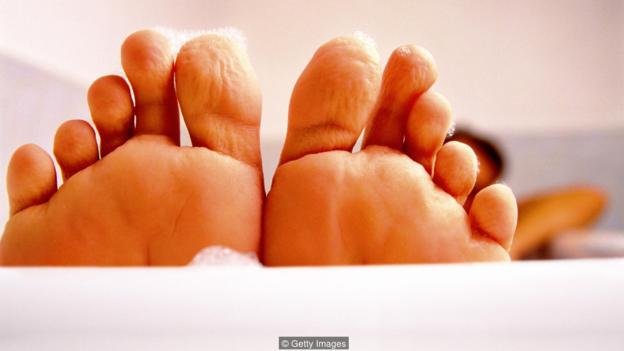Why skin in water shrinks
- Transfer

Some parts of the human skin on which hair does not grow, have a unique reaction to contact with water. Unlike the rest of the body, the skin on the fingers and toes, the palms and the feet wrinkles after being soaked. Five minutes is usually enough.
But why do these skin areas frown? Some believe that this is a biochemical reaction, an osmotic process in which water draws chemicals from the skin, and as a result, the skin dries out.
But a hundred years ago, scientists knew that this reaction was not explained by a simple reflex or the result of osmosis.
Surgeons have discovered that if you cut certain nerves in your fingers, the effect of wrinkled skin disappears. Consequently, this effect is associated with a working nervous system. As a result, this effect was even suggested to be used as a test for the efficiency of the sympathetic nervous system in patients who do not respond to other influences.
So on this issue the scientific community has reached a consensus. But the reason why, in the course of evolution, the effect of wrinkling of the skin appeared when wet, and whether it is associated with any adaptation mechanism, remains a matter of debate.
Neurobiologist Mark Changizi [ the Mark Changizi ] of 2AI Labs believe that this effect - adaptation. Recall the pattern on the surface of the tire. In dry weather, smooth tires adhere better to asphalt, so racing cars have smooth tires without a pattern. But when driving in the rain tires with a pattern become safer.
In 2011, Changizi and his colleagues discovered evidence that shriveled fingers actually work in a tire-like manner, drawing water from fingers and toes in wet conditions, and allowing primates — specifically, humans and macaques — to maintain a firm grip.
In other words, wrinkles, appearing from the effects of water, can be considered tiny systems for drainage. The river consists of streams flowing into it, and the land between the streams is not connected with each other.
To check whether the wrinkled skin on the fingers looked like a branching river system, Changizi and the team studied 28 photographs of human fingers. They found that the drawing of shriveled fingers is an inverted copy of the river systems - in it the elevated parts are interconnected, and between them are not connected tubules.

In this case, the rises are not located anyhow; their drawing is quite meaningful. The rivers accumulate water, and the tubules on the fingers should drain it. "Pressing the tip of a finger on a wet surface drains the liquid out from under it through the tubules, and after that the whole finger gets contact with the surface," the researchers described the effect.
In addition, wrinkles do not appear within the first five minutes after wetting, so casual contact with water passes without a trace. Such a reaction occurs only in the rain or during the dew. In addition, wrinkles from freshwater appear faster than from the sea - perhaps these are echoes of the conditions in which such a mechanism first appeared in primates.
Even if this mechanism arose and not directly to enhance the grip, it can be saved for this reason.A 2013 study by British neurologists found evidence that shriveled fingers help people work with wet objects.
In the experiment, 20 people had to move 45 objects of different sizes - pebbles and sinkers - from one container to another. In some cases, they were dry, while the skin of different subjects was both smooth and shriveled. In other cases, the objects were wet. It was found that it was easier to carry wet objects with shriveled fingers, and there was no difference for dry objects.
However, a similar study conducted in 2014German researchers found the opposite effect. 40 people carried 52 balls and dice of various sizes and weights between containers. Scientists did not find a difference in the ability to handle these objects, regardless of whether the fingers of the subjects were wrinkled or not, and the objects were dry or wet.
Similarly, a group of Taiwanese researchers conducted experiments with a volunteer. They measured the friction between a smooth surface and its smooth or shriveled fingers. They also tested the subject's ability to bring the ends of the spring together. They found that in each of the tests the results were worse when working with shriveled fingers.

Of course, if the wrinkling effect appeared as a result of adaptation, it was tested in more natural conditions than the laboratory ones.
Changini believes that this effect is useful for maintaining the weight of the whole body, and not for manipulating small objects. “If we even conduct tests where the effect matters, then for this you need to grab the trees or heavy objects, not the balls,” he says. “[When transferring balls between containers], hydroplaning does not threaten you.” It is necessary to associate this effect with movement, not dexterity.
It turns out that the ideal experiment, in his words, is to hire parkour lovers who show their tricks with both smooth and shriveled skin, alternately in dry and wet conditions. “Only somehow you need to ensure their safety,” he adds.
